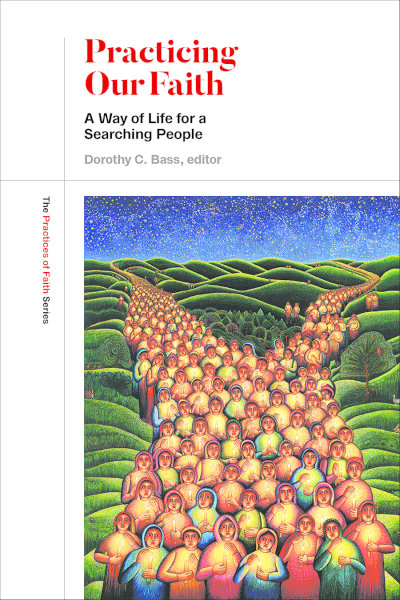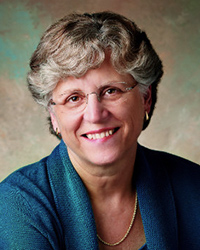July 12, 2022
Dorothy C. Bass: Christian practices and a way of life abundant

The influential book “Practicing Our Faith” and other works it inspired continue to be pertinent today. A new website invites a new generation to explore Christian practices vital to faithful living.
Twenty-five years ago, the book “Practicing Our Faith: A Way of Life for a Searching People,” compiled and edited by Dorothy C. Bass, initiated a conversation about Christian practices that continues today.
“Practicing Our Faith” inspired a score of other books that explored specific practices, addressed different age groups, and encouraged theological reflection on practices in seminaries.
Bass, a practical theologian and historian of Christianity, has spoken widely on practices, vocation and spirituality. Her most recent book is “Stepmother: Redeeming a Disdained Vocation,” published by Broadleaf Books in April 2022.
She and Craig Dykstra — a major contributor to “Practicing Our Faith” — also led conversations and events about faith practices.

“The book ‘Practicing Our Faith’ and the [companion] website are intended as resources for communities’ conversations about the practices that shape their way of life, both when they are gathered and when they are sent out into the world to love and serve God and their neighbors,” Bass said.
A revised second edition of “Practicing Our Faith” was released in 2019, and a new iteration of the website, produced by Leadership Education at Duke Divinity, recently launched.
The site invites congregational leaders into reflection and conversation about Christian practices, drawing on books sponsored by the Valparaiso Project on the Education and Formation of People in Faith, of which Bass was the longtime director.
Bass spoke with Faith & Leadership’s Sally Hicks about this work and its continuing usefulness. The following is an edited transcript.

Faith & Leadership: Let’s go back to the beginning. How did this project get started?
Dorothy C. Bass: Thanks for asking. It was during the early 1990s, in the midst of what appeared to be, ironically, both an increase in spiritual hunger in the wider culture and a growing sense of decline within mainline Protestantism.
Craig Dykstra, a scholar of Christian education who had just become vice president for religion at Lilly Endowment, had an idea for renewing Christian education and formation that departed from long-standing emphases on individual learning and classroom-style instruction.
He was convinced that the richness and diversity of the long, broad Christian tradition contained resources (including a capacity for self-criticism) that might be retrieved, articulated in fresh ways and shared, empowering contemporary Christians to grow in faith in rapidly changing times, for their own well-being and the well-being of the world.
Craig invited me — a church historian — to work with him in developing an approach that emphasized faith formation through learning, critical reflection and participation in what we called Christian practices.
F&L: What do you mean by Christian practices?
DB: Attention to practice, practices and praxis was already in the air at the time we began, as liberation, feminist and other theologians led the way in addressing the embodied, real-world implications of Christian faith. We listened to these voices throughout.
Our approach was also influenced by renewed philosophical attention to social practices and how they shape communities of meaning and purpose (most notably, for us, in the work of Alasdair MacIntyre).
I’m oversimplifying, but the important points we took were that practices are communal and embodied; they extend over long periods of time, adapt to changing contexts, and carry within them the meanings and questions of the traditioned communities to which they belong.
Practices, in this sense, are shared activities that resist individualistic and primarily intellectual notions of Christian life and faith.
Craig and I invited a dozen other educators and theologians to join us in developing this concept and how it might guide contemporary Christians in educating and forming persons and communities in our rapidly changing world.
Together, this group discerned a set of practices that Christians have embraced across history and cultures as they seek to live, as we put it in the book, “in response to and in the light of God’s active presence for the life of the world in Christ Jesus.”
We chose practices like forgiveness, hospitality, Sabbath keeping, household economics and testimony. Such shared activities are not only things we do in worship or while “at church,” though they are definitely present there.
They also address fundamental human needs and aim at the well-being of all. Such practices can take different specific forms in different cultures, but family resemblances (often arising from biblical sources) are evident.
We eventually realized that what we were really doing was describing an entire way of life by considering it one practice at a time. Interestingly, practices like these get woven together by necessity; you start doing one, and you stumble into the others.
Lacking all Sabbath, for example, hospitality will wither, and without forgiveness, none of the practices can continue for long. As we worked with these ideas over the years, we came to understand this way of life as a way of life abundant — practiced (that is, rehearsed) while we are together as church and in worship, but also practiced (that is, lived out) wherever we go in God’s great creation.
F&L: Your project was very collaborative; “Practicing Our Faith” was the joint effort of 13 authors. Why was that, and what difference did it make?
DB: Let’s start by noticing that practices themselves are intrinsically collaborative. Communities perform and pass on each of these practices, and communities are also called to figure out what shape each practice can best take within their own distinctive contexts.
In a sense, that’s what our group of writers did. I love a blurb that Parker Palmer wrote for the book’s first edition: “Practicing Our Faith is a book written by a remarkable community of people — remarkable … because its members prayed and talked and worked together to create this volume, modeling the way the church is meant to do its work.”
Christian practices can become channels of God’s active presence for us and for the life of the world. But like every human venture, they can also get broken, stuck or deformed. Most of the time, I believe, both aspects are in play in how we actually live. We rely throughout on the grace of God.
Healthy communities of practice need to reflect critically on their practices, while also seeking out the wisdom about practices that is available in Scripture and in the practices of previous generations and diverse communities around the world today.
To support this purpose, many study guides are available on the website, and the second edition (2010 and 2019) of “Practicing Our Faith” contains ideas for using this material in a congregation or in a college or seminary class.
F&L: As the website demonstrates, this way of thinking about a way of life grew far beyond the initial book. How did reflection on Christian practices grow over time?
DB: People who go to the website will find many resources that expand on the insights in the initial book. I’ll briefly outline what’s there and how they are interconnected.
After “Practicing Our Faith” was published, we consulted with church and seminary leaders about what needs and questions deserved further attention, and we kept consulting at each stage beyond that as well.
I’ll share some high points of what came from that ongoing process.
There was eagerness to dig more deeply into some of the specific practices. This led to books by Don and Emily Saliers (“A Song to Sing, A Life to Live”), Stephanie Paulsell (“Honoring the Body”), and others.
We also sensed an important opportunity to encourage reflection on practices across generations. And so Don Richter and I gathered a group of adults and youth to write “Way to Live: Christian Practices for Teens,” which has been widely used and is supported by an excellent study guide.
Susan Briehl and I then gathered a group to address the questions and yearnings of emerging adults (college age or in their 20s), which led to the book and study guide “On Our Way: Christian Practices for Living a Whole Life.”
In addition, Bonnie Miller-McLemore wrote a wonderful book about how practices play out in family life with children: “In the Midst of Chaos: Caring for Children as Spiritual Practice.”
It was also important to develop more fully the theological foundations of this work. While practices are, first of all, embodied activities, they are always also full of meaning and thought.
What we believe shapes how we live — and how we live shapes how we believe. So Craig Dykstra and I gathered a group of eminent theologians to work on this interplay, with key leadership coming from Miroslav Volf. The result was “Practicing Theology: Beliefs and Practices in Christian Life.”
Some of these theologians continued into another seminar, which also included pastors, to consider the implications of this approach; the result was “For Life Abundant: Practical Theology, Theological Education and Christian Ministry.”
Finally, a few members of that group continued to explore these concerns by identifying the kind of knowledge that undergirds excellent practice in “Christian Practical Wisdom: What It Is, Why It Matters.”
When I think about the impact of our work on Christian practices, these books provide the most concrete examples. But many communities have also explored practices in their own contexts, so it’s impossible for me to know what the full impact has been and may continue to be. Some of what these communities did is included on the website.
F&L: What are you thinking about now?
DB: The climate emergency is my foremost concern. Awareness of this crisis has grown for me and for many others in recent years; it’s something I now think we didn’t give enough attention.
In “Practicing Our Faith,” we wrapped this concern within a more encompassing practice we called “household economics” — referring to households of many kinds, from our homes to our planet. In “Way to Live” and “On Our Way,” the practice of caring for creation got a fuller treatment.
Now, the urgency of the crisis and the efforts to address it grow daily. Practices thinking can be helpful, I’m finding, in that it requires practitioners to make connections between what’s happening in their personal, congregational, regional, national and planetary households.
Also, this approach integrates attention to shared, embodied action with rigorous reflection on how Christians have thought about and embodied (or failed to embody) the practice.
I am inspired by the energy of today’s climate advocates, and also by the theologians, novelists and others who are deepening my awareness of why and how we must develop our practice in this area.
I also brought practices thinking to my latest book, “Stepmother: Redeeming a Disdained Vocation,” where my own story is interwoven with lots of research on this challenging but crucial role. As I learned to walk a path of reconciliation and love, opportunities to practice (rehearse) reconciliation within Christian worship and community formed me over time to practice (live out) a more reconciling approach to stepfamily life.
I want to end with a word of thanks to all those who have contributed over the years to this way of thinking about a way of life, especially Craig Dykstra, Don Richter and Susan Briehl.
This work, like practices themselves, is collaborative. I urge anyone reading this interview to find collaborators and conversation partners as you consider how the resources available at the website might deepen your community’s way of life abundant in your distinctive context.


Share